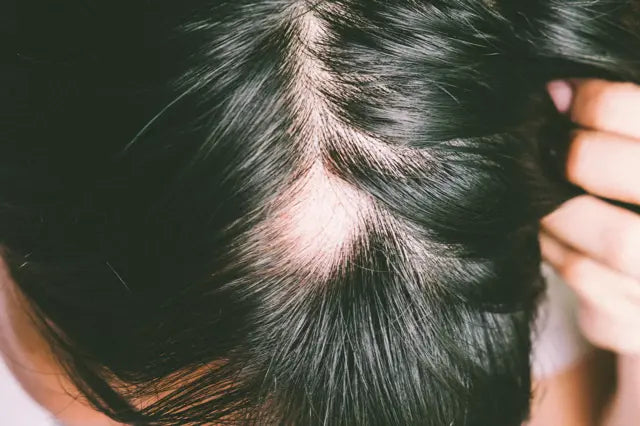WHAT ARE THE DIFFERENT TYPES OF ALOPECIA?

Alopecia is the medical term for losing more hair than is replenished, resulting in thinning or balding. Occurring at any age, alopecia primarily affects the scalp and can sometimes disrupt hair growth on beards, eyebrows, eyelashes and other parts of the body.
Many different types of alopecia exist, each with their own symptoms and differing degrees of severity. To help you pinpoint which strain you might be suffering from, we’ve compiled a comprehensive list of common and uncommon types of alopecia as well as ways to cope with the condition, ranging from online support groups to products and treatments.
WHAT ARE THE MOST COMMON TYPES OF ALOPECIA?
1. Alopecia Areata
This is an autoimmune condition with a genetic pre-disposition that causes the body’s immune system to attack hair follicles, leading to patchy hair loss. These coin-sized patches of baldness most commonly occur on the scalp but can appear anywhere on the body1.Alopecia areata can affect all ages and genders, although it is most prevalent in teenagers and young adults. More than 50% present before the age of 20. There is currently no cure for it, however regrowth of hair typically occurs over a period of months or years (this is much more likely for those with mild early alopecia).
2. Alopecia Barbae
Alopecia barbae is a localized form of alopecia that affects the beard region. While not as extreme as other strains of alopecia, it still results in sporadic hair loss (usually in the form of small patches, but sometimes across the entire beard area)2.Historically, alopecia barbae has tended to correlate with psychological and physical stress; managing your stress levels appropriately and putting aside time to unwind will aid recovery.
3. Traction Alopecia
Traction hair loss is mechanical in cause rather than genetic. This is caused by hairstyles which pull the hair back so tightly that over time there is destruction of the hair follicle resulting in hair loss. Permanent hair loss can occur when such excessive tension is applied, since new hair follicles cannot develop3.It is therefore advisable to lessen the tension exerted on your scalp and opt for a hairstyle which avoids tugging at the roots.
4. Telogen Effluvium
This condition is generally triggered by a disruption in the hair growth cycle. The cause can be any number of physiological factors including drugs, a nutritional imbalance and stress or trauma (such as childbirth, bereavement and serious illness) with up to 30% or more of scalp hair shifting to the telogen (shedding) phase – three times the normal amount4.This is usually a temporary condition and hair regrowth is therefore to be expected once the causative factor is addressed. Adopting a balanced and nutritious diet helps to support healthy regrowth; a poor diet lacking in essential vitamins for the hair can prevent it from obtaining the nutrients it needs to thrive.
5. Androgenetic Alopecia
This condition is commonly known as male or female pattern baldness and in men often results in a receding hairline and thinning crown. Women, on the other hand, the hair thinning is most pronounced in the midline parting of the scalp and are rarely left completely bald5.There is no cure for androgenetic alopecia. However, its progression is slow and can span several decades.
WHAT ARE THE RARER TYPES OF ALOPECIA?
1. Alopecia Totalis
Alopecia totalis affects both men and women. It is a more advanced form of alopecia areata that causes hair loss on the face and entire scalp. The chances of alopecia areata resolving itself after reaching the alopecia totalis stage are small, although in some isolated cases hair follicles can start to grow again6.
2. Alopecia Universalis
The most advanced form of alopecia areata, alopecia universalis usually presents itself later on in life and occurs in both men and women. This condition results in total hair loss all over the entire body. The exact cause is unknown, although doctors believe certain factors may increase the risk. While there is no cure, it has been noted that hair regrowth can occur on its own in some cases7.
3. Cicatricial Alopecia (Scarring Alopecia)
Cicatricial alopecia not only causes permanent hair loss but also scarring of the scalp. Brought about by a group of rare disorders which destroy the hair follicle, cicatricial alopecia occurs worldwide and affects both men and women but is uncommon in children(8).
4. Anagen Effluvium
Normally caused by an acute injury to the hair follicles typically a toxin, infection but often caused by drugs such as cancer treatment drugs, anagen effluvium results in patchy hair loss and eventually a total loss of hair (it usually grows back after treatment ceases).
5. Frontal Fibrosing Alopecia
This condition is characterized by hair loss and scarring on the frontal scalp (forehead). Around half of all people affected by frontal fibrosing alopecia also experience a loss of eyebrows too and, in some cases, eyelashes(9).
HOW CAN I TREAT ALOPECIA?
If you recognize any of the hair loss patterns outlined above, we recommend seeking advice from your doctor or trichologist who will be able to confirm which type of alopecia you are experiencing. Although losing your hair can be understandably upsetting and difficult to come to terms with, there are a number of treatments (both medicinal and product-focused) for alopecia which can help you regain confidence by disguising the effects of hair loss. Nioxin’s consultation tool is specifically designed to match you with the most appropriate product for your hair type and the level of thinning you are experiencing.
References:
https://www.healthline.com/health/alopecia-areata
https://www.healthline.com/health/alopecia-barbae#what-is-alopecia-barbae
https://www.alopecia.org.uk/pages/faqs/category/types-of-alopecia
https://www.trichologists.org.uk/conditions/hair-conditions/
https://ghr.nlm.nih.gov/condition/androgenetic-alopecia
https://www.healthline.com/health/alopecia-totalis
https://rarediseases.info.nih.gov/diseases/614/alopecia-universalis
https://www.alopecia.org.uk/pages/faqs/category/types-of-alopecia
https://rarediseases.info.nih.gov/diseases/10886/frontal-fibrosing-alopecia
